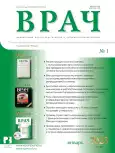The problem of iodine deficiency in children
- Авторлар: Kravtsova O.N.1, Sagitova E.R.1, Averyanov V.N.1
-
Мекемелер:
- Orenburg State Medical University, Ministry of Health of Russia
- Шығарылым: Том 34, № 1 (2023)
- Беттер: 37-39
- Бөлім: From Practice
- URL: https://journals.rcsi.science/0236-3054/article/view/143029
- DOI: https://doi.org/10.29296/25877305-2023-01-07
- ID: 143029
Дәйексөз келтіру
Аннотация
The authors analyze the prevalence of thyroid diseases associated with iodine deficiency in children under 14 years of age, by using Registration Form No. 12 “Information on the number of diseases registered in patients living within the service area of a healthcare facility” of children’s polyclinics, Orenburg City Clinical Hospital Five, over 2018–2021. They consider diseases, such as subclinical hypothyroidism due to iodine deficiency and other hypothyroidism forms, endemic goiter associated with iodine deficiency, as well as other forms of non-toxic goiter.
Негізгі сөздер
Толық мәтін
##article.viewOnOriginalSite##Авторлар туралы
O. Kravtsova
Orenburg State Medical University, Ministry of Health of Russia
Хат алмасуға жауапты Автор.
Email: sagel.8181@mail.ru
ORCID iD: 0000-0001-8114-7159
Candidate of Medical Sciences
Ресей, OrenburgE. Sagitova
Orenburg State Medical University, Ministry of Health of Russia
Email: sagel.8181@mail.ru
ORCID iD: 0000-0001-6492-0824
Candidate of Medical Sciences
Ресей, OrenburgV. Averyanov
Orenburg State Medical University, Ministry of Health of Russia
Email: sagel.8181@mail.ru
Doctor of Medical Sciences
Ресей, OrenburgӘдебиет тізімі
- Melnichenko G.A., Troshina E.A., Platonova N.M. et al. Iodine deficiency thyroid disease in the Russian Federation: the current state of the problem. Аnalytical review of publications and data of official state statistics (Rosstat). Consilium Medicum. 2019; 21 (4): 14–20 (in Russ.). doi: 10.26442/20751753.2019.4.190337
- Alferova V.I., Mustafina S.V., Rymar O.D. Iodine status of the population in Russia and the world: what do we have for 2019? Clinical and experimental thyroidology. 2019; 15 (2): 73–82 (in Russ.). doi: 10.14341/ket10353
- Klinicheskie rekomendatsii Rossiiskoi assotsiatsii endokrinologov i Rossiiskoi assotsiatsii vrachei ul'trazvukovoi diagnostiki po zabolevaniyam i sostoyaniyam, svyazannye s defitsitom ioda. M.: Rossiiskaya assotsiatsiya endokrinologov, 2020; 44 р. (in Russ.).
- Bezlepkina O.B. Pediatric endocrinological service in the Russian Federation: current state and development prospects. Problems of Endocrinology. 2020; 66 (5): 4–6 (in Russ.). doi: 10.14341/probl12689
- Dedov I.I., Platonova N.M., Troshina E.A. et al. Prevention of iodine deficiency diseases: focus on regional targeted programs. Problems of Endocrinology. 2022; 68 (3): 16–20 (in Russ.). doi: 10.14341/probl13119
- Platonova N.M. Iodine deficiency: current status. Clinical and experimental thyroidology. 2015; 11 (1): 12–21 (in Russ.). doi: 10.14341/ket2015112-21
- Sviridonova M.A. Iodine Deficiency and Human Development. Clinical and experimental thyroidology. 2014; 10 (1): 9–20 (in Russ.). doi: 10.14341/CET20141019-20
- Peterkova V.A., Vitebskaya A.V., Geppe N.A. Spravochnik pediatra po detskoi endokrinologii. M.: Verdi, 2016; 144 р. (in Russ.).
Қосымша файлдар













